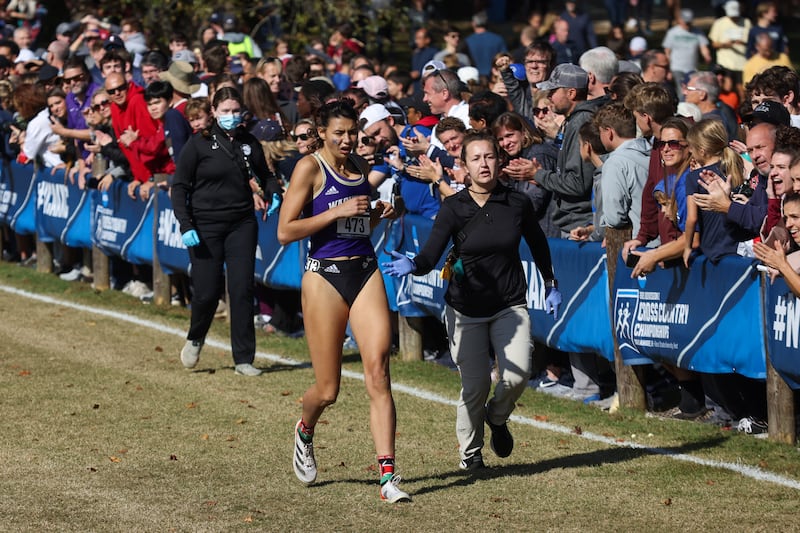That time of the season again. For countless Irish distance runners over the years, the big autumn goal has always been the National Collegiate Athletic Association (NCAA) cross-country championships, which brings together the best college athletes from across America and increasingly far beyond.
Running since 1938, and for the women since 1981, it’s been the long-time breeding ground for some of the most talented Irish athletes, that presence notably strong again when the 2022 event takes place this Saturday in Stillwater, home of Oklahoma State University.
The NCAAs also make for one of the last proper cross-country seasons, where athletes get in a solid block of races to build a strong base of winter aerobic work ahead of the 2023 track season.
This past weekend, the NCAA regional qualifiers were held across nine regions: the top-two seven-athlete teams qualify automatically, plus another 13 ‘wild-card’ teams, based on their results throughout the season, making for 31 teams in all, men and women. There are also 38 at-large individual qualifiers, who were top-25 in their region.
READ MORE
It all makes for two of the most competitive cross-country races anywhere, with the obvious exception of the World Cross-Country, and hardest to win. Only two Irish-born men have managed since 1938, Neil Cusack in 1972, and Keith Kelly in 2000.
I was at Chambers Bay Golf Course last weekend for the West Regionals, watching my daughter Sophie race with the University of Washington. Brian Fay from Dublin also competes for Washington, and there was plenty to cheer when he stormed away with 800m to go to take the win, also leading his team to qualify in third place.
Sophie had her best result of the season, placing ninth, also leading the Huskies to third place, safely qualified for ‘The Show’, as they call it, just eight days later.
It was nice to be able to drive just over two hours from Portland and share in some of that NCAA experience all over again, the first I’ve been back to since 1991, when I was running for Villanova.
While standing around at the start, Regina Joyce, one of the Irish women trailblazers in NCAA running in the 1980s, came up to introduce herself. A name I was well familiar with, we’d never actually crossed paths.
Regina set the inaugural Irish women’s 5,000m record in 1982, running 15:35.60, as well as competing in the very first women’s Olympic marathon in Los Angeles in 1984, after setting an Irish record and finishing seventh in the World Championships marathon in 1983.
She also ran for Washington, making for another nice connection, and it was a pleasure to walk back and forth across the course together, cheering on the Washington women’s team, sharing some other memories from years gone by.
She raced that first women’s NCAA cross-country in 1981, finishing 11th, was second a year later, and still holds the Washington college record over 3,000m, at 8:55.05. It’s not so commonly raced now, with the 3,000m steeplechase on the NCAA schedule, still a nice little target for Sophie over the next two years perhaps.

The NCAA has gone properly international now, those West Regionals alone seeing athletes representing Italy, Poland, Australia, Bulgaria, Canada, Ireland and Britain, plus the US, in the top-10 places.
It’s a good study to identify all the nationalities when it comes to NCAA finals, then follow and track as they move on to the next stage of their careers. Not everyone continues on to World and Olympic level, although a great many do. There’s so much tactics and race practice at the NCAA level, once an athlete finally makes a breakthrough they will often have learned the essential racing skills throughout their college career.
Only twice in 40 years since 1981 has there not been any Irish representative in the women’s race; this year there will likely be 15 Irish athletes, five women and 10 men.
Providence College will have the greatest representation, long-time coach Ray Treacy still attracting the cream of Irish female distance runners to the Providence, Rhode Island campus. The Providence women, who have been dominating the Big East and Northeast region already this season, go into the NCAA Championships ranked 18th, with freshman Jane Buckley from Bandon AC one of the standout athletes this year, winning the Big East Championships three weeks ago.
The Irish standouts in the men will likely be Fay, Barry Keane of Butler, winner of the Great Lakes region, the Tulsa trio of Michael Power, Shay McEvoy and Cormac Dalton. Charlie O’Donavan (Villanova), Feargal Curtin (Florida State University) will also likely be in the mix.
It’s a difficult enough task for the men, racing 10km cross-country over successive weekends, and a lot will be determined by the recovery between races and ability to rise again to the challenge, eight days later, in a much more competitive field.
It’s a race of intensity unlike any other too, masses of runners crossing the line together in the space of 10 seconds. You could very easily lose or indeed gain 30 places, so it’s always good to have something left as you approach the finish, rather than be struggling to hold on.
It’s all about balancing your effort through the race, knowing when to push hard, when to hold back and defend your position. You want to get out fast, only not too fast, maintain a good work rate through the middle part of the race, then be in a position to push in the final few hundred metres, when so much ground can be made up.
The big difference now, compared to earlier years, particularly in the women’s race, is the depth and the number of athletes that can keep up for a good portion of the race. It’s not just about running, but also fighting to hold your ground, maintain some space, so you can be comfortable running and not feel too contained.
If you are in the pack and you can relax and get pulled along and save energy until the real race begins, then things will always start to open up, and moves can be made.
From the spectator, the NCAAs are also two of the greatest races to watch, even more so when you have a vested interest, and those races within the race, individuals pushing up to improve their own place, or the place of their team.
It definitely brings me back to my Villanova days, running through the energy and excitement, the flags and colourful hats and jerseys outside the ropes and the near-constant carnival-like noise.
You could finish in the top-10, the top-50, the top-100, and depending on your experience consider that a good run, and an experience which will unquestionably stand to any runner as they look to build a successful career.

















